Introduction
Termites (Insecta: Blattodea: Isoptera) are eusocial insects whose colonies are composed of reproductives (queens and kings), sterile adults (workers and soldiers), neotenics (future winged adults) and juveniles (nymphs) (Krishna, 1969). The name of this infraorder, coined by French entomologist Gastard Auguste Brullé, comes from the combination of the prefix iso, which means “equal”, and the word pteron, which means “wing”, referencing the subequal size of the anterior and posterior wings of the winged individuals (Krishna et al., 2013a). This infraorder currently comprises a little more than 3100 species grouped in 12 families and 330 genera, including both recent and fossil species (Krishna et al., 2013a).
Termites are distributed in all geographic zones of the world except for the Antarctica (Jones & Eggleton, 2001). The region formed by Canada, continental USA, and Mexico, has a termite fauna comprised of 89 species (including the new records) which are grouped in 26 genera and 4 families. Canada is home to 7 species (2 of them introduced) and one subspecies, these are grouped in 4 genera and 3 families (Evans et al., 2013; Krishna et al., 2013b; c; Snyder, 1949). Of these three countries, Canada is the one that shows the least termite diversity, its native termite fauna being represented entirely by Nearctic species. Continental USA has 47 species (5 of them introduced) and two subspecies, these are grouped in 18 genera and 4 families (Evans et al., 2013; Krishna et al., 2013b-f; Light, 1934b; Snyder, 1949); with a few exceptions found in the southern regions of the country (states of Texas and Florida), most of the native termite fauna of continental USA also correspond to Nearctic species. Mexico has the greatest diversity among these countries with 69 species (2 of them introduced) and a subspecies, which are grouped in 24 genera and 4 families (Evans et al., 2013; Cancello & Myles, 2000; Krishna et al., 2013b-f; Light, 1934c; Méndez-Montiel & Equihua-Martínez, 2001; Scheffrahn, 2016; Snyder, 1949); the termite fauna native to Mexico is a mixture of Nearctic and Neotropical species.
The objective of this article is to provide an illustrated key for the identification of families and genera of termites found in Canada, continental USA, and Mexico, including introduced taxa. Given the key works mainly for the Nearctic region, it pairs well with the key provided by Constantino (2002) for the Neotropics. An updated checklist of the species found in the region is provided, including the geographic distribution to state level in the case of species and subspecies found in Mexico. New state and country records of termites are made for Mexico.
Materials and methods
For the elaboration of the identification key presented in this article, the key from Krishna et al. (2013a) was modified so as to only include the Canadian, American and Mexican genera of the families Archotermopsidae, Kalotermitidae and Rhinotermitidae, discarding the rest; elements of the keys proposed in the works of Constantino (2002b) and Mill (1983) were also included as to add the genera of Termitidae of this region. Original and subsequent descriptions of the genera, as well as identification keys that included them, were also consulted: Banks and Snyder (1920), Bourguignon et al. (2010), Constantino (1994; 2002b), Harris (1960), Krishna (1961; 1962; 1970), Krishna and Emerson (1962), Light (1930a; b; 1932; 1933; 1935; 1937), Lim and Forschler (2012), Maiti (2006), Nickle and Collins (1989; 1990; 1992), Nutting (1990), Scheffrahn (2011; 2016) Scheffrahn and Křeček (2001), Scheffrahn and Su (1994), Scheffrahn et al. (1989; 2000; 2003; 2006; 2015), Snyder (1920; 1922; 1924a-c; 1925a; b; 1926a-c; 1929; 1933; 1952). To illustrate the key, photographs from the official page of the University of Florida Termite Collection (UFTC) https://www.termitediversity.org/ (Scheffrahn, 2020a) were used. The key uses terminology found in Light (1934a), Ricart et al. (2015) and Weesner (1969); an illustration of the termite soldier was redrawn from Light (1934a) for general reference (Fig. 1).
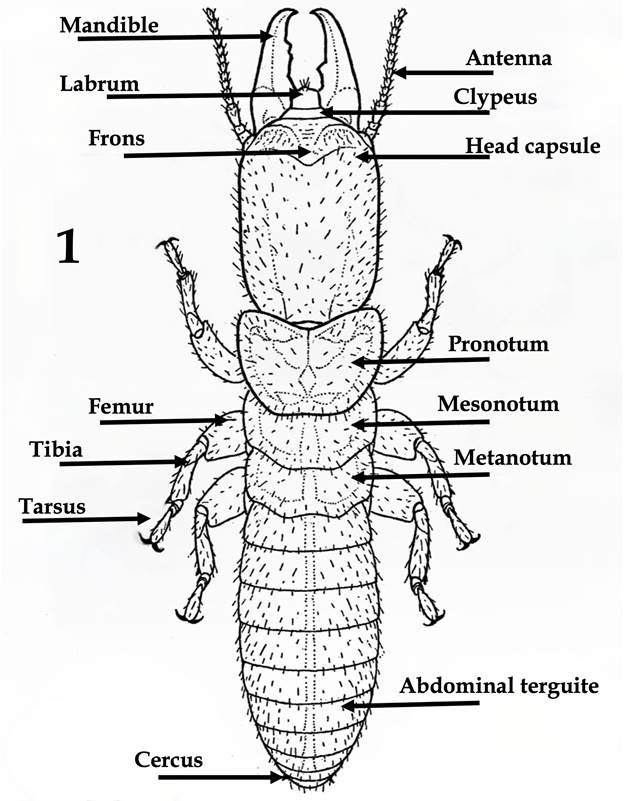
Figure 1 General external anatomy of the termite soldier caste; redrawn of a mandibulate soldier of Incisitermes minor (Kalotermitidae) from Light (1934a).
The species checklist is based on the bibliographic revision of the following articles: Araujo (1970; 1977), Banks and Snyder (1920), Cancello and Myles (2000), Capetillo-Concepción et al. (2019), Constantino (1994; 1998; 2002a), Ferraz and Méndez-Montiel (2004), Goellner (1931), Harris (1960), Hernández and Armas (1995), Hernández-Rodríguez et al. (2015), Krishna (1961; 1962), Krishna et al. (2013b-f), Light (1930a; b; 1932; 1933; 1935; 1937), Lim and Forschler (2012), Méndez-Montiel and Equihua-Martínez (2001), Myles (1995; 1997), Myles and Méndez-Montiel (2017a-d), Nalepa (1998), Nutting (1969; 1970), Scheffrahn (2011; 2016; 2020b; c), Scheffrahn and Křeček (2001), Scheffrahn and Rust (1983), Scheffrahn and Su (1987; 1995; 2005), Scheffrahn et al. (1988; 1989; 1998; 2000; 2001; 2002; 2005; 2006; 2015), Snyder (1920; 1922; 1924a-c; 1925a; b; 1926a-c; 1929; 1933; 1952), Su et al. (1997) and Weesner (1970). The database containing the records of the UFTC (Scheffrahn, 2020a), updated the 31st of July 2020 at the time of writing, was also used.
Results
I. Key to the termite (Insecta: Blattodea: Isoptera) families and genera present in Canada, continental USA, and Mexico
The following dichotomous key is based mainly in the soldier caste, although keys 1 and 4 refer to the worker caste; it includes both native and introduced taxa. Abbreviatures of the countries they can be found in are located at the right of each genus (CA = Canada, US = USA, MX = Mexico).
1 Soldier caste present, mandibulate (Fig. 2A), nasutiform (Fig. 2B) or mandibulate nasutiform (Fig. 2C) …………………………………………………………………………………………………..……………………….... 2
- Soldier caste absent; worker fore tibiae inflated compared to middle and hind tibiae (Fig. 3A); left mandible with a notch between fused first and second marginal teeth and third marginal tooth (Fig. 3B) .................................................................... TERMITIDAE: Anoplotermes US, MX
2 Large mandibulate soldier; antennae with more than 20 articles (Fig. 4A); prominent cerci in all castes (Fig. 4B) ................................................... ARCHOTERMOPSIDAE: Zootermopsis CA, US, MX
-Soldiers variable; antennae with less than 20 articles; cerci not as above .................................. 3
3 Mandibulate soldier with pronotum subequal or wider than the head (Fig. 5A) ............................................................................................................................................ KALOTERMITIDAE: 4
- Soldier variable, pronotum clearly narrower than the head (Fig. 5B) .......................................... 14
4 Apex of anterior tibiae of the soldier armed with a thick, conspicuous spur compared to those of the other legs (Fig. 6A); worker with mesonotal rasp (Fig. 6B) ... Calcaritermes US, MX
- Anterior tibiae without enlarged spur; worker without rasp ............................................................ 5
5 Head dark, rugose and quadrate, with short and thick mandibles (Fig. 7A-B); frontal flange robust, with frons steeply angled from vertex (Fig. 7A-B) .......................... Cryptotermes CA, US, MX
- Head longer, not rugose nor quadrate; frontal flange absent or forming a weak ridge; frons obtusely angled to vertex; mandibles longer ......................................................................................... 6
6 Frontal flange, in lateral view, forming elevated ridge (Fig. 8); mandibles ≥70% the length of the head (Figs. 8, 9A) .................................................................................................................................. 7
- Frontal flange without elevated ridge; mandibles <70% the length of the head .................... 8
7 Third antennal article very large, clavate, longer than the next four articles combined (Fig. 9A) ...................................................................................................................................... Marginitermes US, MX
- Third antennal article not clavate, slightly longer than fourth article (Fig. 8) ............................................................................................................................................... Procryptotermes MX
8 In dorsal view, head rectangular, head width <2.5 mm ..................................................................... 9
- In dorsal view, head ellipsoidal (Fig. 9BB); head width >2.5 mm ....................... Pterotermes US, MX
9 Third antennal article more than twice as long as the fourth (Figs. 9C, 10A-C) ...................... 10
- Third antennal article less than twice as long as the fourth (Fig. 11A-C) .................................. 12
10 In dorsal view, pronotum less than twice as wide as median length, anterior margin incised/etched (Fig. 9C) .................................................................................................... Incisitermes US, MX
- In dorsal view, pronotum twice as wide as median length, anterior margin evenly concave (Fig. 10A-B) ........................................................................................................................................................ 11
11 Larger species, head width 2.2-2.9 mm and widely rectangular (Fig. 10A); mandibles robust (Fig. 10A); anterolateral ridges absent above antennal carinae (Fig. 10A) ..... Neotermes US, MX
- Smaller species, head with 1.3-1.6 mm and narrowly rectangular (Fig. 10B); anterolateral ridges above antennal carinae (Fig. 10B-C) .................................................................... Rugitermes MX
12 Mandibles more than twice as wide at base than their total length (Fig. 11A); subterranean wood feeder ................................................................................................................... Paraneotermes US, MX
- Mandibles less than twice as wide at base than their total length (Fig. 11B-C); not subterranean .................................................................................................................................................... 13
13 Third antennal article shorter and narrower than fourth (Fig. 11B) .................. Glyptotermes MX
- Third antennal article longer and wider than fourth (Fig. 11C) ............................... Kalotermes US
14 Mandibulate soldier; pronotum flattened (Fig. 12A) ................................ RHINOTERMITIDAE: 15
- Soldier variable (Fig. 2A-C); pronotum saddle-shaped in lateral view (Fig. 12B) ..................................................................................................................................................... TERMITIDAE: 18
15 Head ovoid in dorsal view, with fontanelle noticeable on dorsum or anterior view of the head (Fig. 13A-B) ............................................................................................................................................. 16
- Head sub-rectangular in dorsal view, with fontanelle inconspicuous or absent (Fig. 14A-B) ................................................................................................................................................................................ 17
16 Fontanelle small and circular, opening dorsally (Fig. 13A); defensive secretion not apparent .................................................................................................................................................. Prorhinotermes US
- Fontanelle large and ovoid opening anteriorly (Fig. 13B-C); defensive secretion copious, white ..................................................................................................................................... Coptotermes US, MX
17 Mandibles with narrow bases, linear except for 30º curvature in distal fourth (Fig. 14A) ................................................................................................................................................ Heterotermes US, MX
- Mandibles with robust bases, 60-90º curvature in distal third (Fig. 14B) .......................................................................................................................................... Reticulitermes CA, US, MX
18 Nasutiform (Fig. 2B) or mandibulate nasutiform (Fig. 2C) soldier ................................................ 19
- Mandibulate soldier (Fig. 2A) ..................................................................................................................... 22
19 Nasutiform soldier with vestigial mandibles (Figs. 2B, 12B, 15A-B) ............................................. 20
- Nasutiform soldier with sharp, functional mandibles (Fig. 2C) ....................... Cahuallitermes MX
20 Head, in dorsal view, with marked constriction behind antennae (Fig. 2BB) ........................................................................................................................................ Tenuirostritermes US, MX
- Head drop-shaped, without said constriction (Fig. 15A-B) ............................................................. 21
21 Head dark (Fig. 15A) ....................................................................................................... Nasutitermes US, MX
- Head yellowish orange (Fig. 15B) ...................................................................................... Parvitermes MX
22 Mandibles about as long as the head and stick-like (Fig. 16A); anterodorsum of the head with well-developed, pointed process (Fig. 16B) ................................................................. Termes MX
- Head without said process; mandibles curved in dorsal view ........................................................ 23
23 Base of the mandibles originate at common center, with inner edge of the mandibles serrated (Fig. 17A) ..................................................................................................... Microcerotermes US, MX
- Base of the mandibles originate near anterolateral corners of the head, with inner edge of mandibles smooth (Figs. 2A, 5B, 17B) ...................................................................................................... 24
24 Head width greater than 1.8 mm, with mandibles robust, shorter than head width (Fig. 17B) ........................................................................................................................................................Hoplotermes MX
- Head width less than 1.4 mm; mandibles narrower, usually longer than head width .......... 25
25 Mandibles straight, curved only at the tip and as long or longer than head length (Fig. 5B) ......................................................................................................................................... Gnathamitermes US, MX
- Mandibles curved, usually shorter than head length (Fig. 2A) ........................... Amitermes US, MX

Figure 2 Dorsal view of head capsule of the soldier of three species of the family Termitidae. A) Amitermes beaumonti; B) Tenuirostritermes cinereus; C) Cahuallitermes intermedius.
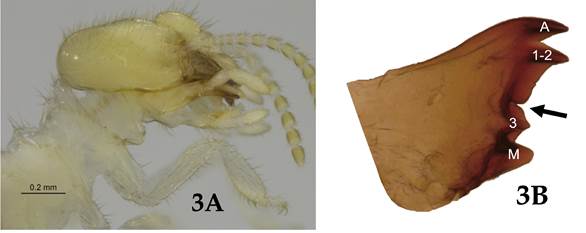
Figure 3 Worker of Anoplotermes fumosus. A) anterior lateral view of the body; B) left mandible: A = apical tooth, 1-2 = fusion of the first and second marginal teeth, 3 = third marginal tooth, M = molar protrusion, black arrow points to the location of the notch.

Figure 4 Soldier of Zootermopsis angusticollis. A) dorsal head capsule; B) ventral view of the abdomen, white arrow points to the cercus.

Figure 5 Dorsal view of the head capsule and pronotum of two species of termites. A) Kalotermes approximates; B) Gnathamitermes perplexus. Arrows used to show the difference in width of the head capsule and pronotum.

Figure 6 Two species of Calcaritermes. A) Calcaritermes emarginicollis, spur of the frontal tibia of the soldier; B) Calcaritermes sp., dorsal view of the anterior portion of the body of the worker, the rasp is encircled in black.

Figure 7 Soldier of Cryptotermes abruptus. A) anterior part of the pronotum and dorsal view of the head capsule; B) lateral view of the head capsule and pronotum.
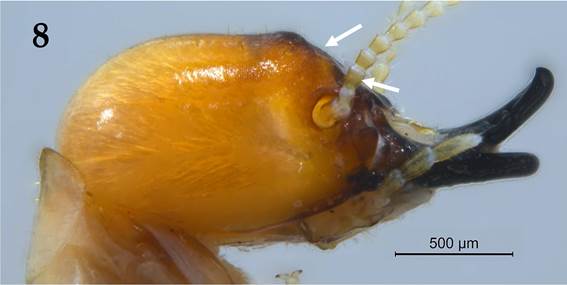
Figure 8 Lateral view of the head capsule and pronotum of Procryptotermes hesperus, left arrow points to the ridge, right arrow points to the third antennal article.
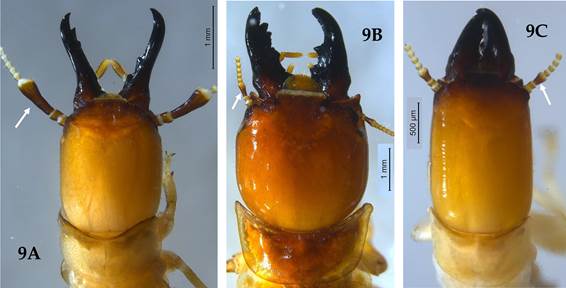
Figure 9 Dorsal view of the head capsule and pronotum of soldiers of three species of Kalotermitidae. A) Marginitermes hubbardi; B) Pterotermes occidentis; C) Incisitermes schwarzi; white arrows points to the third antennal article.
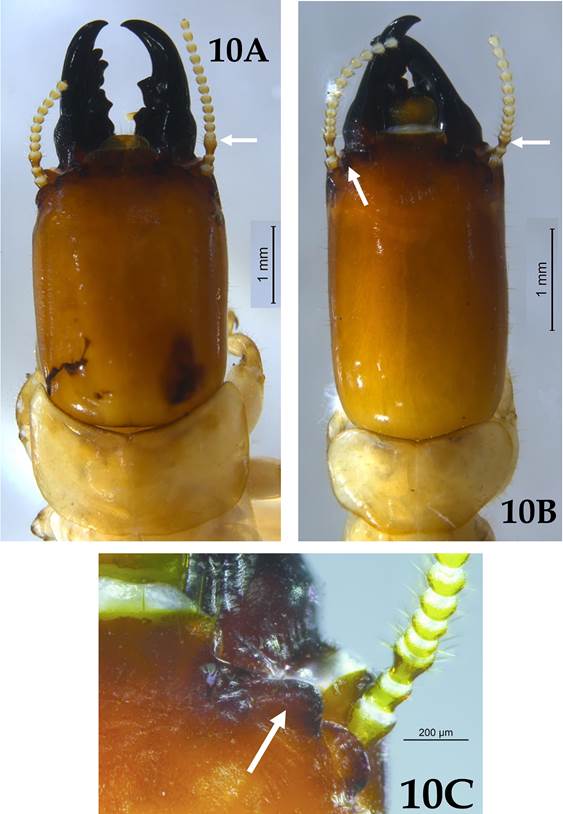
Figure 10 Dorsal view of the head capsules and pronotums of soldiers of two species of Kalotermitidae. A) Neotermes jouteli, white arrows points to the third antennal article; B) Rugitermes unicolor, left arrow points to the ridge above antennal carina, right arrow points to the third antennal article; C) Rugitermes unicolor; white arrow points to the ridge above antennal carina.
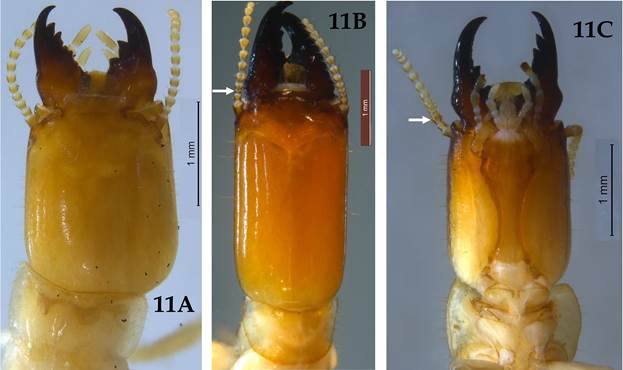
Figure 11 Head capsule and pronotum of soldiers of three species of Kalotermitidae. A) dorsal view of Paraneotermes simplicicornis; B) dorsal view of Glyptotermes seeversi, white arrow points to the third antennal article; C) ventral view of Kalotermes approximatus, right arrow points to the third antennal article.

Figure 12 Lateral view of the head capsules and pronotums of two species of termites. A) Coptotermes testaceus; B) Tenuirostritermes incisus.
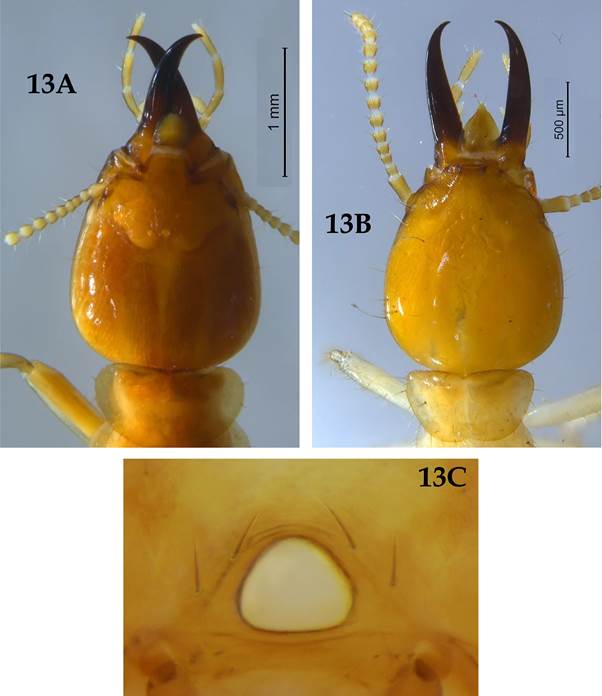
Figure 13 Soldiers of two species of Rhinotermitidae. A) Prorhinotermes simplex, dorsal view of head capsule and pronotum; B) Coptotermes testaceus, dorsal view of head capsule and pronotum. C) Coptotermes testaceus, frontal view of the fontanelle.
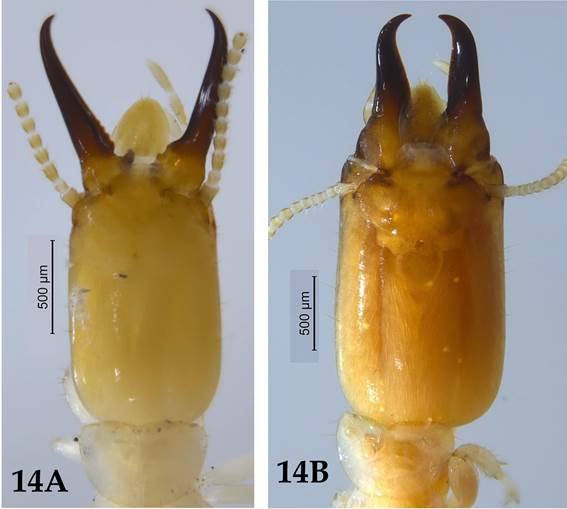
Figure 14 Dorsal view of the head capsule and pronotum of two species of Rhinotermitidae. A) Heterotermes aureus. B) Reticulitermes flavipes.
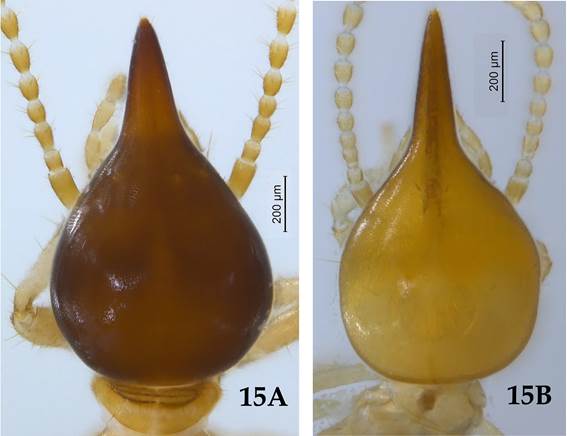
Figure 15 Dorsal view of the head capsule and pronotum of two species of Termitidae. A) Nasutitermes corniger. B) Parvitermes yucatanus.
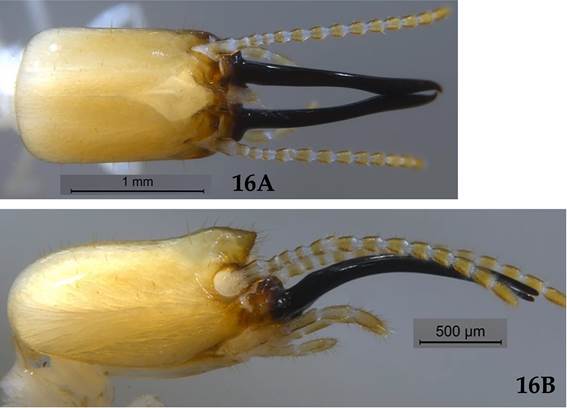
Figure 16 Soldier of Termes hispaniolae. A) dorsal view of the head capsule. B) lateral view of the head capsule.
II. List of termites (Blattodea: Isoptera) of Canada, continental USA, and Mexico
Checklist of termites (Blattodea: Isoptera) recorded for Canada, USA, and Mexico, including state records for the latter country and the status if they are introduced. An asterisk (*) is located at the right of each country or state from which new records are provided in the following section.
Order BLATTODEA Wattenwyl, 1882
Infraorder ISOPTERA Brullé, 1832
Family ARCHOTERMOPSIDAE Engel, Grimaldi & Krishna 2009
Genus Zootermopsis Emerson, 1933
1. Zootermopsis angusticollis (Hagen, 1858). Canada, USA, Mexico (Baja California Sur)
2. Zootermopsis laticeps (Banks, 1906). USA, Mexico (Chihuahua, Sonora)
3. Zootermopsis nevadensis (Hagen, 1874). Canada, USA, Mexico (Baja California, Sonora)
3a. Zootermopsis nevadensis nevadensis (Hagen, 1874). Canada, USA, Mexico (Baja California)
3b. Zootermopsis nevadensis nuttingi Haverty & Throne, 1989. USA
Family KALOTERMITIDAE Froggatt, 1897
Genus CalcaritermesSnyder, 1925
4. Calcaritermes coleiKrishna, 1962. Mexico (San Luis Potosi)
5. Calcaritermes nearcticus (Snyder, 1933). USA
6. Calcaritermes parvinotus (Light, 1933). Mexico (Colima, Jalisco)
Genus Cryptotermes Banks, 1906
7. Cryptotermes abruptusScheffrahn Scheffrahn & Křeček, 1998. Mexico (Campeche*, Quintana Roo, Yucatan*)
8. Cryptotermes brevis (Walker, 1853). Introduced to Canada, USA, Mexico (Colima, Guerrero, Oaxaca, Veracruz)
9. Cryptotermes cavifrons Banks, 1906. USA, Mexico* (Campeche*, Quintana Roo*)
10. Cryptotermes fatulus (Light, 1935). Mexico (Nayarit)
11. Cryptotermes longicollis Banks, 1918. Mexico (Jalisco, Sinaloa)
Genus Glyptotermes Froggatt, 1897
12. Glyptotermes seeversiKrishna & Emerson, 1962. Mexico (Veracruz)
Genus IncisitermesKrishna, 1961
13. Incisitermes banksi (Snyder, 1920). USA, Mexico* (Sonora*)
14. Incisitermes emersoni (Light, 1933). Mexico (Colima, Jalisco)
15. Incisitermes fruticavus Ruset, 1979. USA
16. Incisitermes marginipennis (Latreille, 1817). Mexico (Chiapas, Ciudad de Mexico, Colima, Estado de Mexico, Guerrero, Jalisco, Michoacan, Nayarit, Oaxaca, Puebla, Tlaxcala, Veracruz*)
17. Incisitermes milleri (Emerson, 1943). USA
18. Incisitermes minor (Hagen, 1858). USA, Mexico (Baja California, Sonora).; introduced to Canada.
19. Incisitermes platycephalus (Light, 1933). Mexico (Chiapas, Colima, Jalisco, Oaxaca)
20. Incisitermes schwarzi (Banks, 1919). USA, Mexico (Campeche*, Yucatan, Quintana Roo)
21. Incisitermes seeversi (Snyder & Emerson, 1949). Mexico (Nayarit)
22. Incisitermes snyderi (Light, 1933). USA, Mexico (Nuevo Leon*, Tabasco)
Genus Kalotermes Hagen, 1853
23. Kalotermes approximatusSnyder, 1920. USA
Genus MarginitermesKrishna, 1961
24. Marginitermes cactiphagusMyles, 1997. Mexico (Baja California Sur, Veracruz*)
25. Marginitermes hubbardi (Banks, 1920). USA, Mexico (Colima, Jalisco, Sinaloa, Sonora)
Genus Neotermes Holmgren, 1911
26. Neotermes castaneus (Burmeister, 1839). USA
27. Neotermes holmgreni Banks, 1918. Mexico* (Quintana Roo*)
28. Neotermes jouteli (Banks, 1919). USA, Mexico (Campeche*, Colima, Jalisco, Quintana Roo, Sinaloa, Veracruz, Yucatan)
29. Neotermes larseni (Light, 1935). Mexico (Jalisco)
30. Neotermes luykxiNickle & Collins, 1989. USA
31. Neotermes mona (Banks, 1919). Mexico* (Quintana Roo*)
32. Neotermes phragmosus Křeček & Scheffrahn, 2003. Mexico* (Quintana Roo*)
Genus ParaneotermesLight, 1934
33. Paraneotermes simplicicornis (Banks, 1920). USA, Mexico (Baja California Sur, Sinaloa)
Genus Procryptotermes Holmgren, 1910
34. Procryptotermes hesperusScheffrahn & Křeček, 2001. Mexico (Quintana Roo)
Genus Pterotermes Holmgren, 1911
35. Pterotermes occidentis (Walker, 1853). USA, Mexico (Baja California Sur, Sonora)
Genus Rugitermes Holmgren, 1911
36. Rugitermes unicolorSnyder, 1952. Mexico (Chiapas)
Family RHINOTERMITIDAE Froggatt, 1897
Genus Coptotermes Wasmann, 1896
37. Coptotermes formosanus Shiraki, 1909. Introduced to USA
38. Coptotermes gestroi (Wasmann, 1896). Introduced to USA and Mexico (Ciudad de Mexico, Colima)
39. Coptotermes testaceus (Linnaeus, 1758). Mexico (Campeche, Chiapas, Colima, Guerrero, Jalisco, Nayarit, Oaxaca, Tabasco, Veracruz, Quintana Roo)
Genus Heterotermes Froggatt, 1897
40. Heterotermes aureus (Snyder, 1920). USA, Mexico (Aguascalientes*, Baja California, Baja California Sur*, Sonora, Nayarit)
41. Heterotermes convexinotatus (Snyder, 1924). USA, Mexico (Campeche*, Chiapas*, Colima, Jalisco, Nayarit, Oaxaca*, Quintana Roo*, Sinaloa, Veracruz*, Yucatan*)
42. Heterotermes maculatusLight, 1933 Mexico. (Aguascalientes, Guanajuato, Jalisco)
43. Heterotermes tenuis (Hagen, 1858) Mexico. (Aguascalientes*)
Genus Prorhinotermes Silvestri, 1909
44. Prothinotermes simplex (Hagen, 1858). USA
Genus Reticulitermes Holmgren, 1913
45. Reticulitermes arenincolaGoellner, 1931. USA
46. Reticulitermes flavipes (Kollar, 1837). USA, Mexico (Coahuila, Nuevo Leon, Tamaulipas); introduced to Canada
47. Reticulitermes hageniBanks, 1920. USA
48. Reticulitermes hesperusBanks, 1920. Canada, USA, Mexico (Baja California, Chihuahua)
49. Reticulitermes malletei Howard & Clément, 1985. USA
50. Reticulitermes nelsonaeLim & Forschler, 2012. USA
51. Reticulitermes tibialisBanks, 1920. USA, Mexico (Jalisco*, Nuevo Leon*, Tamaulipas)
52. Reticulitermes virginicus (Banks, 1907). USA, Canada
Family TERMITIDAE Latreille, 1802
Genus Amitermes Silvestri, 1901
53. Amitermes beaumonti Banks, 1918. Mexico (Campeche, Chiapas, Quintana Roo*, Tabasco, Veracruz, Yucatan)
54. Amitermes coachellaeLight, 1930. USA
55. Amitermes cryptodonLight, 1930. Mexico (Colima, Guerrero, Jalisco, Yucatan)
56. Amitermes emersoniLight, 1930. USA
57. Amitermes ensiferLight, 1930. Mexico (Colima, Jalisco)
58. Amitermes floridensisScheffrahn Scheffrahn, Su & Mangold, 1989. USA
59. Amitermes minimusLight, 1932. USA
60. Amitermes pallidusLight, 1932. USA
61. Amitermes parvulusLight, 1932. USA, Mexico (Jalisco)
62. Amitermes silvestrianusLight, 1930. USA
63. Amitermes snyderiLight, 1930. USA
64. Amitermes wheeleri (Desneux, 1906). USA, Mexico (Colima, Jalisco, Sinaloa)
Genus Anoplotermes Müller, 1873
65. Anoplotermes fumosus (Hagen, 1860). USA, Mexico (Aguascalientes*, Chiapas*, Jalisco, Quintana Roo*, Sinaloa, Veracruz)
Genus Cahuallitermes Constantino, 1944
66. Cahuallitermes aduncusConstantino, 1994. Mexico (Chiapas)
67. Cahuallitermes intermedius (Snyder, 1922). Mexico (Campeche, Chiapas, Quintana Roo, Tabasco, Yucatan*)
Genus GnathamitermesLight, 1932
68. Gnathamitermes grandis (Light, 1930). Mexico (Aguascalientes*, Jalisco, Nayarit)
69. Gnathamitermes nigriceps (Light, 1930). Mexico (Colima, Guerrero, Puebla)
70. Gnathamitermes perplexus (Banks, 1920). USA, Mexico (Jalisco, Sinaloa)
71. Gnathamitermes tubiformans (Buckley, 1862). USA, Mexico (Coahuila, Jalisco, Nuevo Leon, Tamaulipas)
Genus HoplotermesLight, 1933
72. Hoplotermes amplusLight, 1933. Mexico (Colima, Jalisco, Sonora)
Genus Microcerotermes Silvestri, 1901
73. Microcerotermes bouvieri (Desneux, 1904). Mexico (Guerrero, Oaxaca)
74. Microcerotermes gracilisLight, 1933. Mexico (Chiapas*, Colima, Jalisco)
75. Microcerotermes septentrionalisLight, 1933. Mexico (Baja California*, Campeche*, Chiapas*, Colima, Jalisco, Oaxaca, Quintana Roo*, Yucatan*)
Genus Nasutitermes Dudley, 1890
76. Nasutitermes colimaeLight, 1933. Mexico (Colima)
77. Nasutitermes corniger (Motschulsky, 1855). Mexico (Campeche, Chiapas, Quintana Roo, Tabasco); introduced to USA.
78. Nasutitermes ephratae (Holmgren, 1910). Mexico (Campeche*, Chiapas, Quintana Roo, Veracruz)
79. Nasutitermes nigriceps (Haldeman, 1854). Mexico (Campeche, Chiapas*, Colima, Guerrero, Jalisco, Nayarit, Oaxaca, Quintana Roo, Sinaloa, Tabasco, Veracruz, Yucatan*)
80. Nasutitermes pictusLight, 1933. Mexico (Colima)
Genus Parvitermes Emerson, 1949
81. Parvitermes mexicanus (Light, 1933). Mexico (Colima, Jalisco, Oaxaca, Quintana Roo, Sonora*, Tabasco)
82. Parvitermes yucatanusScheffrahn, 2016. Mexico (Campeche, Quintana Roo)
Genus Tenuirostritermes Holmgren, 1912
83. Tenuirostritermes briciae (Snyder, 1922). Mexico (Chiapas, Jalisco, Nayarit, Quintana Roo*, Veracruz)
84. Tenuirostritermes cinereus (Buckley, 1862). USA, Mexico (Veracruz, Tamaulipas)
85. Tenuirostritermes incisus (Snyder, 1922). Mexico (Campeche, Guerrero, Jalisco*)
86. Tenuirostritermes strenuus (Hagen, 1860). Mexico (Veracruz)
87. Tenuirostritermes tenuirostris (Desneux, 1904). USA, Mexico (Colima, Jalisco, Veracruz)
Genus Termes Linnaeus, 1758
88. Termes hispaniolae (Banks, 1918). Mexico (Campeche*, Chiapas, Colima, Oaxaca*, Quintana Roo)
89. Termes panamaensis (Snyder, 1923). Mexico (Colima, Jalisco)
III. New country and state records of termites (Blattodea: Isoptera) for Mexico
Based on material deposited in the UFTC (Scheffrahn, 2020a), records of five species of Kalotermitidae previously not known from Mexico are reported: Cryptotermes cavifrons, Incisitermes banksi, Neotermes holmgreni, Neotermes mona and Neotermes phragmosus. Additionally, 32 new state records of 19 species of termites (families Kalotermitidae, Rhinotermitidae and Termitidae) are also reported for Mexico.
Amitermes beaumonti Banks, 1918 (Termitidae)
Material examined. MEXICO: Quintana Roo: 8 soldiers, road to Colonia Yucatan 17.5km east Tizimin (21.1615°N, -87.9925°W), 07/December/1997, Chase/Mangold (UFTC-MX123); unspecified number of soldiers, highway 180292km marker (21.0971°N, -86.9691°W), 10/December/97, Chase/Mangold (UFTC-MX196); 9 soldiers, highway 180 292km marker (21.0971°N, -86.9691°W), 10/December/1997, Chase/Mangold (UFTC-MX198); 4 soldiers, highway 180292km marker (21.0971°N, -86.9691°W), 10/December/1997, Chase/Mangold (UFTC-MX199); unspecified number of soldiers, 0.5km south of Valladolid Nuevo (20.9342°N, -87.3227°W), 10/December/1997, Chase/Mangold (UFTC-MX204); 3 soldiers, Leona Vicario highway 180 270km marker (21.0065°N, -87.1530°W), 10/December/1997, Chase/Mangold (UFTC-MX208); 11 soldiers, approximately 30km west of Chet. inter. (18.4852°N, -88.4825°W), 21/January/2001, Chase/Mangold (UFTC-MX257); 2 soldiers, approximately 30km west of Chet. inter. (18.4852°N, -88.4825°W), 21/January/2001, Chase/Mangold (UFTC-MX258); unspecified number of soldiers, 2km north of San Jose (18.4409°N, -89.0025°W), 21/January/2001, Chase/Mangold (UFTC-MX266); unspecified number of soldiers, Chicanna Ecovillage (18.5178°N, 89.4846°W), 21/January/2001, Chase/Mangold (UFTC-MX278); 1 soldier, 5km west of Chancah Veracruz (19.4906°N, -88.0282°W), 23/January/2001, Chase/Mangold (UFTC-MX324); 4 soldiers, 5km west of Chancah Veracruz (19.4906°N, -88.0282°W), 23/January/2001, Chase/Mangold (UFTC-MX325); unspecified number of soldiers, 5km west of Chancah Veracruz (19.4906°N, -88.0282°W), 23/January/2001, Chase/Mangold (UFTC-MX326); unspecified number of soldiers, 41.5km north of Coba toward Nuevo X-can (20.8377°N, -87.6015°W), 22/January/2003, Chase/Mangold (UFTC-MX501); 1 soldier, 41.5km north of Coba toward Nuevo X-can (20.8377°N, -87.6015°W), 22/January/2003, Chase/Mangold (UFTC-MX502); 4 soldiers, 53.3km south of Chiquila (21.0245°N, -87.4977°W), 25/January/2003, Chase/Mangold (UFTC-MX565).
These represent new state records for Quintana Roo, Mexico.
Anoplotermes fumosus (Hagen, 1860) (Termitidae)
Material examined. MEXICO: Aguascalientes: Unspecified number of workers, Aguascalientes (21.8855°N, -102.2933°W), 04/July/1996, P. Ban (UFCT-MX597). Chiapas: Unspecified number of workers, city park in Tapachula (14.9000°N, -92.2800°W), 10/June/2006, R. Setter (UFTC-MX587). Quintana Roo: Unspecified number of workers and 3 nymphs, 25km north on road to Coba from Tulum (20.3750°N, -87.6000°W), 22/January/2003, Chase/Mangold (UFTC-MX475); unspecified number of workers, 28km north of Coba toward Nuevo X-can (20.7247°N, -87.5907°W), 22/January/2003, Chase/Mangold (UFTC-MX496); unspecified number of workers, on highway 28.5 km south of Chiquila (21.2317°N, -87.4381°W), 25/January/2003, Chase/Mangold (UFTC-MX560); 3 workers, Tulum (20.2170°N, -87.4622°W), 21/January/2003, Chase/Mangold (MX568).
These represent new state records for Aguascalientes, Chiapas and Quintana Roo, Mexico.
Cahuallitermes intermedius (Snyder, 1922) (Termitidae)
Material examined. MEXICO: Yucatan: 2 soldiers, 96km east of Merida (20.7544°N, -88.7406ºW), 16/January/2003, Chase/Mangold (UFTC-MX348); 1 soldier, highway 180 between Chemax and Nuevo X-can (20.6894°N, -87.8960°W), 25/Jan/2003, Chase/Mangold (UFTC-MX523); 2 soldiers, highway 180 between Chemax and Nuevo X-can (20.6894°N, -87.8960°W), 25/Jan/2003, Chase/Mangold (UFTC-MX524).
These represent new state records for Yucatan, Mexico.
Cryptotermes abruptusScheffrahn & Křeček, 1998 (Kalotermitidae)
Material examined. MEXICO: Campeche: unspecified number of workers, 10km east of Xpujil (18.5002°N, -89.3501°W), 21/January/2001, Chase/Mangold (UFTC-MX271); 2 soldiers, El Ramonal south of Conhuas (18.2887°N, -89.8381°W), 22/January/2001, Chase/Mangold (UFTC-MX285). Yucatan: 1 soldier, Dzilam de Bravo (21.3937°N, -88.8903°W), 19/January/2003, Chase/Mangold (UFTC-MX444).
These represent new state records for Campeche and Yucatan, Mexico.
Cryptotermes cavifrons Banks, 1906 (Kalotermitidae)
Material examined. MEXICO: Campeche: 1 soldier, Manos Rojas (18.5392°N, -89.8946°W), 22/January/2001, Chase/Mangold (UFTC-MX297). Quintana Roo: 2 soldiers, Leona Vicario highway 180 270km marker (21.0065°N, -87.1530°W), 10/December/1997, Chase/Mangold (UFTC-MX209); 2 soldiers, 2km south of Los Limones (18.9608°N, -88.1349°W), 21/January/2001, Chase/Mangold (UFTC-MX237); 5 soldiers, Laguna Bacalar (18.7666°N, -88.3386°W), 21/January/2001, Chase/Mangold (UFTC-MX243); 9 soldiers, 16km northwest of Majahual (18.8099°N, -87.7716°W), 23/January/2001, Chase/Mangold (UFTC-MX312); 2 soldiers, 16km northwest of Majahual (18.8099°N, -87.7716°W), 23/January/2001, Chase/Mangold (UFTC-MX313); 2 workers, 5km west of Chancah Veracruz (19.4906°N, -88.0282°W), 23/January/2001, Chase/Mangold (UFTC-MX323); unspecified number of workers, 2km west of Chancah Veracruz (19.4957°N, -88.0019°W), 23/January/2001, Chase/Mangold (UFTC-MX331); 5 soldiers, road to Coba 23km from highway 307 (20.2342°N, -87.4604°W), 22/January/2003, Chase/Mangold (UFTC-MX453); 3 soldiers, 28.5km south of Chiquila (21.2317°N, -87.4381°W), 25/January/2003, Chase/Mangold (UFTC-MX557); 5 soldiers, 28.5km south of Chiquila (21.2317°N, -87.4381°W), 25/January/2003, Chase/Mangold (UFTC-MX558).
These represent the first records for Mexico.
Heterotermes aureus (Snyder, 1920) (Rhinotermitidae)
Material examined. MEXICO: Aguascalientes: 2 soldiers, Aguascalientes (21.8855°N, -102.2933°W), 4/July/1996, P. Ban (UFTC-MX95). Baja California Sur: 3 soldiers, 65km southwest of La Paz (23.7400°N, -110.6200°W), 15/September/1995, T. G. Myles (UFTC-MX17).
These represent new state records for Aguascalientes and Baja California Sur, Mexico.
Heterotermes convexinotatus (Snyder, 1924) (Rhinotermitidae)
Material examined. MEXICO. Campeche: 2 soldiers, Calakmul (18.0924°N, -89.7896°W), 5/September/1995, T. G. Myles, G. A. Myles and Ecomat (UFTC-MX10). Chiapas: 3 soldiers, Tapachula organic cacao plantation (14.9000°N, -92.2800°W), 10/June/2006, R. Setter (UFTC-MX575). Oaxaca: 5 soldiers, Santa Maria Xadani (15.9333°N, -96.0667°W), 28/May/2006, Atkinson (UFTC-MX570). Quintana Roo: 2 soldiers, highway 180 km 307 (21.0206°N, -86.8593°W), 7/December/1997, Chase/Mangold (UFTC-MX103). Veracruz: 2 soldiers, 158km south of Acayucan (16.5255°N, -94.8973°W), 15/January/1997, T. G. Myles and D. A. Muruvanda (UFTC-MX24). Yucatan: 5 soldiers, 37km east of Merida (20.8767°N, -89.2934°W), 16/January/2003, Chase/Mangold (UFTC-MX352).
These represent new state records for Campeche, Chiapas, Oaxaca, Quintana Roo, Veracruz, and Yucatan.
Heterotermes tenuis (Hagen, 1858) (Rhinotermitidae)
Material examined. MEXICO: Aguascalientes: 1 soldier, Aguascalientes (21.8855°N, -102.2933°W), 4/July/1996, P. Ban (UFTC-MX96).
This represents a new state record for Aguascalientes, Mexico.
Incisitermes banksi (Snyder, 1920) (Kalotermitidae)
Material examined. MEXICO: Sonora: 3 soldiers, 10 miles north of Guaymas (28.0769°N, -110.8974°W), 26/February/1989, T. G. Myles (UFTC-MX212).
This represents the first record for Mexico.
Incisitermes marginipennis (Latreille, 1817) (Kalotermitidae)
Material examined. MEXICO: Veracruz: 1 soldier, Fortin de las Flores passing Loma Motel (18.9037°N, -96.9885°W), 25/June/1963, R. E. Woodruff (UFTC-MX60).
This represents a new state record for Veracruz, Mexico.
Incisitermes schwarzi (Banks, 1919) (Kalotermitide)
Material examined. MEXICO: Campeche: 13 soldiers, El Ramonal south of Conhuas (18.3161°N, -89.9730°W), 22/January/2001, Chase/Mangold (UFTC-MX293); 2 soldiers, Manos Rojas (18.5392°N, -89.8946°W), 22/January/2001, Chase/Mangold (UFTC-MX299); 1 major soldier, Campeche (19.8645°N, -90.5104°W), 18/January/2003, Chase/Mangold (UFTC-MX379); unspecified number of minor and major soldiers, Campeche (19.8645°N, -90.5104°W), 18/January/2003, Chase/Mangold (UFTC-MX380); 5 minor and 2 major soldiers, Campeche (19.8645°N, -90.5104°W), 18/January/2003, Chase/Mangold (UFTC-MX381); 1 minor and 1 major soldiers, Campeche (19.8645°N, -90.5104°W), 18/January/2003, Chase/Mangold (UFTC-MX382); 5 minor and 1 major soldiers, Campeche (19.8645°N, -90.5104°W), 18/January/2003, Chase/Mangold (UFTC-MX383); 4 minor and an unspecified number of major soldiers, Campeche (19.8645°N, -90.5104°W), 18/January/2003, Chase/Mangold (UFTC-MX384); 1 minor and 8 major soldiers, Campeche (19.8645°N, -90.5104°W), 18/January/2003, Chase/Mangold (UFTC-MX385); 1 minor and 2 major soldiers, Campeche (19.8645°N, -90.5104°W), 18/January/2003, Chase/Mangold (UFTC-MX386); 4 minor and 3 major soldiers, Campeche (19.8645°N, -90.5104°W), 18/January/2003, Chase/Mangold (UFTC-MX389).
These represent new state records for Campeche, Mexico.
Incisitermes snyderi (Light, 1933) (Kalotermitidae)
Material examined. MEXICO: Nuevo Leon: 1 alate, Monterrey (25.6632°N, -100.578°W), 07/May/1964, Blantom, Brooce and Woodruff (UFTC-MX62); 8 soldiers and 1 alate, Monterrey (25.6632°N, -100.578°W), 20/June/2005 (UFTC-MX221).
These represent new state records for Nuevo Leon, Mexico.
Marginitermes cactiphagusMyles, 1997 (Kalotermitidae)
Material examined. MEXICO: Veracruz: 4 soldiers, Sumidero Planta de Cerveceria Moctezuma (18.9200°N, -97.0000°W), 18/May/1965, H. V. Weems (UFTC-MX211).
This represents a new state record for Veracruz, Mexico.
Nasutitermes ephratae (Holmgren, 1910) (Termitidae)
Material examined. MEXICO: Campeche: 8 soldiers, just west of Chicbul (18.7803°N, -90.9384°W), 17/January/2003 Chase/Mangold (UFTC-MX362).
This represents a new state record for Campeche, Mexico.
Nasutitermes nigriceps (Haldeman, 1854) (Termitidae)
Material examined. MEXICO: Chiapas: 2 soldiers, organic cacao plantation in Tapachula (14.9000°N, -92.2800°W), 10/June/2006, R. Setter (UFTC-MX577); unspecified number of soldiers, organic cacao plantation in Tapachula (14.9000°N, -92.2800°W), 10/June/2006, R. Setter (UFTC-MX578); unspecified number of soldiers, Tapachula very near the coast along roadway (14.9000°N, -92.2800°W), 10/June/2006, R. Setter (UFTC-MX593); unspecified number of soldiers, Tapachula very near the coast along roadway (14.9000°N, -92.2800°W), 10/June/2006, R. Setter (UFTC-MX596); 8 soldiers, Los Naranjos Tapachula (14.9021°N, -92.2641°W), 9/June/2010, Francisco Infante (UFTC-MX603); unspecified number of soldiers, Rancho las Manzanitas (14.9864°N, -92.4014°W), 21/June/2010, Francisco Infante (UFTC-MX607); unspecified number of soldiers, Huerta San Rafael (14.7257°N, -92.3892°W), 18/June/2010, Francisco Infante (UFTC-MX608); unspecified number of soldiers, Huerta el Vergelito (14.6996°N, -92.3061°W), 15/June/2010, Francisco Infante (UFTC-MX610); unspecified number of soldiers, Finca el Carmen (14.7428°N, -92.3564°W), 15/June/2010, Francisco Infante (UFTC-MX611); unspecified number of soldiers, Tapachula international airport (14.7834°N, -92.3591°W), 15/June/2010, Francisco Infante (UFTC-MX612); unspecified number of soldiers, Finca Cazanares (14.7445°N, -92.4041°W), 18/June/2010, Francisco Infante (UFTC-MX613); unspecified number of soldiers, Huerta 3A (14.8033°N, -92.3475°W), 14/June/2010, Francisco Infante (UFTC-MX614); unspecified number of soldiers, Huerta la Escondida (14.6568°N, -92.1880°W), 20/June/2010, Francisco Infante (UFTC-MX615). Yucatan: unspecified number of soldiers, Celestun (20.8581°N, -90.3843°W), 18/January/2003, Chase/Mangold (UFTC-MX409); unspecified number of soldiers, Celestun (20.8581°N, -90.3843°W), 18/January/2003, Chase/Mangold (UFTC-MX410); unspecified number of soldiers, Celestun on highway 281 (20.8569°N, -90.3766°W), 18/January/2003, Chase/Mangold (UFTC-MX416); unspecified number of soldiers, highway 261 along coast 16.5km east of Progreso (21.3127°N, -89.5104°W), 19/January/2003, Chase/Mangold, (UFTC-MX433); unspecified number of soldiers, highway 261 along coast 16.5km east of Progreso (21.3127°N, -89.5104°W), 19/January/2003, Chase/Mangold, (UFTC-MX434); unspecified number of soldiers, 2km south of Telchac port (21.3295°N, -89.2605°W), 19/January/2003, Chase/Mangold (UFTC-MX440); unspecified number of soldiers, 2km south of Telchac port (21.3295°N, -89.2605°W), 19/January/2003, Chase/Mangold (UFTC-MX441); unspecified number of soldiers, 1km south of Dzilam de Bravo (21.3295°N, -89.2605°W), 19/January/2003, Chase/Mangold (UFTC-MX448).
These represent new state records for Chiapas and Yucatan, Mexico.
Neotermes holmgreni Banks, 1918 (Kalotermitidae)
Material examined. MEXICO: Quintana Roo: 5 soldiers, Chiquila (21.4330°N, -87.3343°W), 25/January/2003, Chase/Mangold (UFTC-MX541).
This represents the first record for Mexico.
Neotermes jouteli (Banks, 1919) (Kalotermitidae)
Material examined. MEXICO: Campeche: 3 soldiers, Chicanna Ecovillage (18.5178°N, -89.4846°W), 21/January/2001, Chase/Mangold (UFTC-MX276); 2 soldiers, Chicanna Ecovillage (18.5178°N, -89.4846°W), 21/January/2001, Chase/Mangold (UFTC-MX277). Yucatan: 1 minor soldier, north of Uman exit on highway to Celestum (20.8193°N, -89.7870°W), 18/January/2003, Chase/Mangold (UFTC-MX400); 5 minor and 2 major soldiers, Celestun on highway 281 (20.8569°N, -90.3766°W), 18/January/2003, Chase/Mangold (UFTC-MX415); 1 major soldier, Hunucma to Merida (21.0339°N, -89.7678°W), 18/January/2003, Chase/Mangold (UFTC-MX417); 2 soldiers, 2km south of Telchac port (21.3295°N, -89.2605°W), 19/January/2003, Chase/Mangold (UFTC-MX436); 2 minor and 5 major soldiers, 4km east of Motul (21.0993°N, -89.2270°W), 19/January/2003, Chase/Mangold (UFTC-MX443); 4 minor and 1 major soldier, road to Yalsihon (21.3908°N, -88.5928°W), 19/January/2003, Chase/Mangold (UFTC-MX450); 2 minor and 1 major soldiers, road to Yalsihon (21.3908°N, -88.5928°W), 19/January/2003, Chase/Mangold (UFTC-MX451).
These represent new state records for Campeche and Yucatan, Mexico.
Neotermes mona (Banks, 1919) (Kalotermitidae)
Material examined. MEXICO: Quintana Roo: 5 soldiers, Chiquila (21.4330°N, -87.3343°W), 25/January/2003, Chase/Mangold (UFTC-MX542).
This represents the first record for Mexico.
Neotermes phragmosus Křeček &Scheffrahn, 2003 (Kalotermitidae)
Material examined. MEXICO: Yucatan: 1 dealate and an unspecified number of workers, Celestun on highway 281 (20.8569°N, -90.3766°W), 18/January/2003, Chase/Mangold (UFTC-MX414). Quintana Roo: 2 soldiers, Chiquila (21.4297°N, -87.3459°W), 25/January/2003, Chase/Mangold (UFTC-MX547).
These represent the first records for Mexico.
Parvitermes mexicanus (Light, 1933) (Termitidae)
Material examined. MEXICO: Sonora: unspecified number of soldiers, 2 miles west of Rosario (26.9390°N, -108.7880°W), 31/January/1964, Rach(?) (UFTC-MX623).
This represents a new state record for Sonora, Mexico.
Reticulitermes tibialisBanks, 1920 (Rhinotermitidae)
Material examined. MEXICO: Nuevo Leon: 2 soldiers, Monterrey (25.6858°N, -100.3123°W), 1/September/1998, J. A. Morales (UFTC-MX35); 9 soldiers, San Pedro Garza Garcia (25.6558°N, -100.3702°W), 1/October/1998, J. A. Morales (UFTC-MX36); unspecified number of alates, Monterrey (25.6858°N, -100.3123°W), J. A. Morales (UFTC-MX37); 5 soldiers, Monterrey (25.6858°N, -100.3123°W), 1/September/1998, J. A. Morales (UFTC-MX38); unspecified number of soldiers, Monterrey (25.6858°N, -100.3123°W), 1/September/1998, J. A. Morales (UFTC-MX39); 5 soldiers, Guadalupe (25.6766°N, -100.2604°W), 01/October/1998, J. A. Morales (UFTC-MX39); unspecified number of soldiers, Monterrey (25.6858°N, -100.3123°W), 20/October/1998, J. A. Morales (UFTC-MX41); unspecified number of alates, Monterrey (25.6858°N, -100.3123°W), 1/September/1998, J. A. Morales (UFTC-MX42); 7 alates, Monterrey (25.6858°N, -100.3123°W), 1/September/1998, J. A. Morales (UFTC-MX44); 5 soldiers, Monterrey (25.6858°N, -100.3123°W), 1/September/1998, J. A. Morales (UFTC-MX45); unspecified number of soldiers, Colonia las Torres Monterrey (25.6632°N, -100.578°W), 11/May/1998 (UFTC-MX217); unspecified number of soldiers, Monterrey (25.6632°N, -100.578°W), 11/April/1998 (UFTC-MX218); Mederos Monterrey (25.6632°N, -100.578°W), 20/March/1998 (UFTC-MX220). Jalisco: 2 soldiers, Fraccionamiento Loma Blanca in Zapopan (25.5000°N, 103.5000°W), 8/August/2000 (UFTC-MX223).
These represent new state records for Nuevo Leon and Jalisco, Mexico.
Tenuirostritermes briciae (Snyder, 1922) (Termitidae)
Material examined. MEXICO: Quintana Roo: unspecified number of soldiers, approximately 30km west of Chet. inter. (18.4825°N, -88.7091°W), 21/January/2001, Chase/Mangold (UFTC-MX261); unspecified number of soldiers, 2km north of San Jose (18.4409°N, -89.0025°W), 21/January/2001, Chase/Mangold (UFTC-MX269).
This represents a new state record for Quintana Roo, Mexico.
Tenuirostritermes incisus (Snyder, 1922) (Termitidae)
Material examined. MEXICO: Jalisco: unspecified number of soldiers, Universidad de Guadalajara (20.3236°N, -103.2183°W), 9/December/2011, Jose Luis Navarrete Heredia (UFTC-MX604).
This represents a new state record for Jalisco, Mexico.
Termes hispaniolae (Banks, 1918) (Termitidae)
Material examined. MEXICO: Campeche: unspecified number of workers, 10km east of Xpujil (18.5002°N, -89.3501°W), 21/January/2001, Chase/Mangold (UFTC-MX274); unspecified number of soldiers, El Ramonal south of Conhuas (18.2887°N, -89.8381°W), 22/January/2001, Chase/Mangold (UFTC-MX292); unspecified number of workers, Champotón (19.2311°N, -90.8424°W), 17/January/2003, Chase/Mangold (UFTC-MX355). Oaxaca: 2 soldiers, Tehuantepec (16.4784°N, -95.1566°W), 12/January/1997, T. G. Myles and D. A. Muruvanda (UFTC-MX32).
These represent new state records for Campeche and Oaxaca, Mexico.
Discussion
The termite fauna found in Continental North America is represented by four of the twelve extant families of termites; except for the introduced taxa, the species are akin to either the Neotropical realm, the Nearctic realm, or both (Araujo, 1970; Weesner, 1970). The family Archotermopsidae (dampwood termites) is represented by a single genus (Zootermopsis) of wood-dwelling termites which is found exclusively in the Nearctic realm, the other two genera of this family are found in the Oriental and Palearctic regions; meanwhile, the remaining families (Kalotermitidae, Rhinotermitidae, and Termitidae) have a worldwide distribution. The family Kalotermitidae (drywood termites) is represented by eleven genera of wood-dwelling termites, some are akin to the Nearctic realm (Kalotermes, Marginitermes, Paraneotermes and Pterotermes), some to the Neotropical realm (Glyptotermes, Rugitermes and Procryptotermes), while some are found in both (Calcaritermes, Cryptotermes, Incisitermes and Neotermes). The family Rhinotermitidae (subterranean termites) is represented by four genera, three of which (Coptotermes, Heterotermes, and Reticulitermes) are subterranean termites which can be found in both the Nearctic and the Neotropical realms; the other genus (Prorhinotermes) has a wood-dwelling species associated with coasts and akin to the Neotropical realm. Finally, the family Termitidae (higher termites) is represented by ten genera of mostly subterranean termites, but some can build nests high up in the trees; in the region, all species are akin to the Neotropical realm and can be found in Mexico (Amitermes, Anoplotermes, Cahuallitermes, Gnathamitermes, Hoplotermes, Microcerotermes, Nasutitermes, Parvitermes, Tenuirostritermes, and Termes), but a few species can be found in southernmost USA.
In the works of Cancello and Myles (2000) and Méndez-Montiel and Equihua-Martínez (2001), records of several species for Mexico are questioned, nevertheless, evidence exists to confirm their presence. Neotermes jouteli (Nickle & Collins, 1990; Scheffrahn et al., 2000), Neotermes larseni (Nutting, 1970), Heterotermes convexinotatus (Light, 1934c; 1935 - identified as Heterotermes orthognathus; Nickle & Collins, 1990), Reticulitermes flavipes (Banks & Snyder, 1920; Light, 1934b; Snyder, 1926a), Termes hispaniolae (Light, 1933; 1934c - identified as the next species) and Termes panamaensis (Nickle & Collins, 1990) are part of the Mexican termite fauna, since, besides being mentioned for Mexico in at least one article (without including catalogues), they are distributed naturally in nearby regions, which makes their distribution in Mexico plausible. Coupled with this, Mexican specimens of Heterotermes convexinotatus, Neotermes jouteli, and Termes hispaniolae are represented in the UFTC (Scheffrahn, 2020a).
On the other hand, Microcerotermes strunckii (Sörense, 1884) is eliminated from the listing of Mexican species, due to its only mention for Mexico being from a catalogue (Constantino, 1998). The species Coptotermes crassusSnyder, 1922, Coptotermes havilandi Holmgren, 1911, Incisitermes perparvusLight, 1933, Nasutitermes costalis (Holmgren, 1910), Incisitermes nigritus (Snyder, 1946) and Termes melindaeHarris, 1960, also mentioned as part of the Mexican termite fauna (Cancello & Myles, 2000; Ferraz & Méndez-Montiel, 2004; Méndez-Montiel & Equihua-Martínez, 2001), are eliminated, because at present they are considered synonyms of Coptotermes testaceus (Scheffrahn et al., 2015), Coptotermes gestroi (Maiti, 2006), Incisitermes seeversi (Krishna et al., 2013b), Nasutitermes corniger (Scheffrahn et al., 2005), Incisitermes platycephalus (Scheffrahn, 2020c), and Termes hispaniolae (Scheffrahn, 2020b), respectively. Although Cryptotermes domesticus (Haviland, 1898) and Cryptotermes dudleyi, 1918 Banks have been intercepted in Canada (Myles, 1995), there have not been records of the establishment of colonies of said species in that country, and for that reason they have not been included in the checklist; similar is the case of Incisitermes platycephalus which has been intercepted in the USA (Gay, 1967; 1969 - identified as Incisitermes nigritus). Finally, neither Reticulitermes okanaganensis Szalanski, Austin, Mckern & Matthew, 2006, recorded for Canada and the USA, nor Tenuirostritermes seeversi Mathur & Thapa, 1962, recorded for Mexico, are included in the checklist, this is due to them being considered nomina nuda (Krishna et al., 2013c; e).
The three Mexican states with the highest diversity of termites are Jalisco with 29 species, Colima with 25 species and Quintana Roo with 21 species. In contrast, the states of Durango, Hidalgo, Morelos, Queretaro, and Zacatecas do not have formal records of any species of termite. Setter and Myles (2005) mention the presence of an undescribed species of Microcerotermes Silvestri, 1901 for the state of California, USA, as well as several undescribed species for some Mexican states. Similarly, Méndez-Montiel and Equihua-Martínez (2001), as well as Myles and Méndez-Montiel (2017a-d) mention the presence of several undescribed species of termites for Mexico, therefore, the number of species of termites of this region is expected to increase in the following years.











 nueva página del texto (beta)
nueva página del texto (beta)




